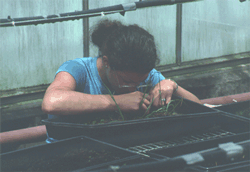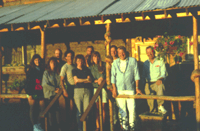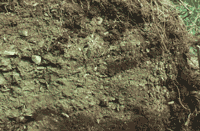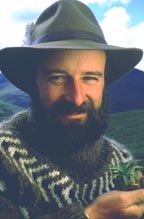
Ecology and Genetics of Seed Banks
As a blissfully ignorant undergraduate field assistant in Alaska, I was put in charge of examining the importance of reproduction by seed in the tundra. I spent days picking apart pieces of tundra in search of the seedlings that weren’t supposed to be there (They were!). I also cleared away the aboveground vegetation from plots to observe dispersal into the bare soil. I observed that seedlings emerged from the soil before seeds were dispersed into the plot! This led to the deduction that long-lived viable seeds existed already in that frozen soil, and eventually the study that emerged led to the first published evidence of a seed bank in the far north. The very existence of an arctic seed bank contradicted previous predictions. It also planted the seeds of many questions about the seed bank that I would not contemplate until later in my career.
When I came to West Virginia University University, Jerry Lang (now Provost of WVU) stimulated my interest in tundra-like communities in the Appalachians. In short order, this led to a comparable seed bank study of Big Run Bog in West Virginia. There, we discovered the largest seed bank ever documented in a natural environment: 377,000 seeds per square meter!
 |
| W.V.U. undergraduate Paula Scumaci counting emerging seedlings from soil cores from Big Run Bog, WV. Paula's glasses prescription was strengthened after this project...and, she's now a massage therapist. |
Our laboratory’s seed bank research went into further long-term dormancy until 1989, when Earthwatch, and eventually the National Science Foundation, funded research expeditions to the arctic to continue exploring the significance of long-term soil seed viability. Our first question was ‘How long can viable seeds remain alive in the soil?’ We performed two experiments to answer this question. One approach involved simply digging downward through the soil profile, germinating seeds from the bottom of that profile, then radiocarbon dating the seed coats from those germinating seeds. The second approach involved employing Earthwatch ‘volunteers’ (62 over the course of three years) to help excavate underneath solifluction lobes to look for buried soil layers, then germinate seeds from these buried profiles and radiocarbon date them. The latter approach had never been tried, but because the soil profile became incorporated into the permafrost as it was buried by the erosional process of solifluction, we were hopeful that this would preclude ‘contamination’ of the ancient seed bank with recent seeds. The use of accelerator mass spectrometry to carbon date the seeds directly was new as well – previous work suggesting ancient seeds always used indirect evidence, resulting in relatively weak inferences about seed age.
 |
| Earthwatch volunteers in Alaska ranged in age from 16 – 76, and were crucial to the discovery of ancient viable seeds in the arctic tundra. |
We discovered a viable long-term seed bank that persisted at least 200 years in the frozen soil under solifluction lobes. Indirect dating suggested ages up to ca. 1000 years for these seeds. Although we examined the seeds buried by solifluction, it is reasonable to assume that such long-term dormancy exists in permafrost not buried by solifluction as well.
 |
| Solifluction lobe excavation. Dark areas show buried soil profile containing long-lived viable seeds of tundra species. |
Our second major question was ‘Can the seed transect under solifluction lobes be used to study genetic change, i.e., microevolution, in the seed producing extant vegetation over time?’. Two of my students, Cindy Bennington and Milan Vavrek attacked this question head-on by making comparisons of morphological and ecological characteristics of old vs. young seeds in the two most common species to emerge from the seed bank. We used a series of common environment and growth chamber studies, combined with isozyme analyses, to answer this question. In both species we found evidence for genetic differences between the populations derived from old and young seeds. As with any historical transect, many causal pathways could lead to such differentiation, but in one case, we found that one of the species showed differentiation with respect to temperature regime, such that old populations tended to perform better under cooler conditions. At the time of seed dispersal of the old population, Alaska, and northern climates generally, experienced the ‘Little Ice Age’. Thus, we may have discovered tacit evidence for adaptive differentiation over time in the seed bank. A second line of evidence for adaptive differentiation over the century time-scale came from transplant experiments, whereby clones of the ‘old’ and ‘recent’ genotypes were planted back into the present field environment to examine relative performance. This research was published in a series of papers that formed the basis of my nomination and selection as Eberly College of Arts and Science Outstanding Researcher, 1993-94.
 |
| Here I am in my grizzly adams days, holding a plant of Luzula parviflora, one of our seed bank species. This plant emerged from seed more than one hundred years old, and was planted back into the natural vegetation to determine how it would fare compared to today's genotypes. |
Numerous presentations were given and three book chapters were written on our findings on buried seeds. Due largely to publicity by Earthwatch, this research was featured in numerous news releases (The Independent, Insight, AP press release), magazine articles (Earthwatch magazine, Alaska Airlines Magazine, Omni), and radio spots (BBC, National Public Radio). In addition, a five-minute segment of a BBC film by Richard Brock entitled ‘Watching Earthwatch’ featured our Alaskan research.
More recent seed bank studies include first-ever documentation of a seed bank in Antarctica and a study of variation in seed bank density with distance from clearcuts in the eastern deciduous forest (Landenberger, Ph.D. dissertation).